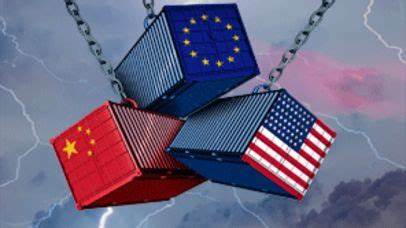The Global Trade War: A Transparent, All-Inclusive Collaborative Analysis

The Global Trade War: A Transparent, All-Inclusive Collaborative Analysis
By Francis John, Editor & Publisher, TipsNews.info, Kansas City
Introduction
The ongoing global trade war, primarily between the U.S. and China but extending to other economies, has reshaped international commerce, politics, and consumer welfare. What began as a dispute over unfair trade practices, intellectual property theft, and tariff imbalances has spiraled into a multi-faceted economic battle with far-reaching consequences.
This article critically examines:
- The origins and escalation of the trade war
- Its impact on consumers, workers, and businesses
- The shifting balance of power—who benefits and who suffers?
- Government accountability and policy failures
- The role of consumers in shaping economic outcomes
- Long-term solutions for Gen Z and future generations

1. Origins of the Trade War: How Did We Get Here?
The U.S.-China trade war officially began in 2018 when the Trump administration imposed tariffs on $50 billion worth of Chinese goods, citing unfair trade practices, forced technology transfers, and intellectual property violations. China retaliated, sparking a cycle of escalating tariffs.
Key Triggers:
- Trade Imbalance: The U.S. trade deficit with China peaked at $419 billion in 2018 (U.S. Census Bureau).
- Intellectual Property (IP) Theft: Estimated losses of $225–600 billion annually due to Chinese IP infringement (Commission on the Theft of American Intellectual Property).
- “Made in China 2025” Policy: Beijing’s state-backed industrial dominance strategy raised fears of market distortion.

Comparative Analysis: U.S. vs. China vs. Global Fallout
| Factor | U.S. Impact | China’s Response | Global Ripple Effect |
|---|---|---|---|
| Tariffs | Higher costs for importers/consumers | Retaliatory tariffs on U.S. agriculture | Supply chain disruptions worldwide |
| Manufacturing Shift | Some jobs returned, but automation reduced gains | Diversified to ASEAN, Mexico, India | Vietnam (+7.2% exports), Mexico (+3.5%) |
| Consumer Prices | +$1,000/year per household (NY Fed) | Inflation in electronics, machinery | Global inflation spike post-pandemic |
2. Who Really Pays? Consumers Bear the Brunt
A. Direct Costs to Consumers
- Price Hikes: Tariffs transferred to consumers—U.S. importers paid over $80 billion in tariffs (Tax Foundation).
- Reduced Quality & Services: Companies cut costs by:
- Using cheaper materials (e.g., electronics with shorter lifespans).
- Reducing customer support (longer wait times, fewer staff).
- Slower deliveries due to disrupted supply chains.
B. Job Losses & Worker Exploitation
- Over 300,000 U.S. jobs lost (U.S. Chamber of Commerce).
- China’s labor market tightened, but layoffs surged in export sectors.
- No Adequate Safety Nets: Governments complain of deficits while failing to retrain displaced workers.
C. Psychological & Generational Distrust
- Gen Z demands instant results—yet sees:
- Rising costs (college debt, housing).
- Stagnant wages.
- Broken political promises.
- Only 34% of Gen Z trusts the government (Pew Research).
3. Who’s Gaining? The Hidden Winners
| Entity | Gains | Losses |
|---|---|---|
| Governments | Increased tariff revenue (short-term) | Long-term economic instability |
| Multinationals | Shifted production to cheaper regions | PR backlash, consumer distrust |
| Elites/CEOs | Stock buybacks, record profits | Worker exploitation scandals |

4. Government Accountability: Why Are Deficits & Blame Games Never Ending?
- Deficit Spending: The U.S. national debt hit $34 trillion (2024)—yet no real trade war resolution.
- Policy Failures:
- No long-term industrial strategy.
- Inadequate worker retraining programs.
- Corporate bailouts without consumer protections.
- Why No Strong Opposition?
- Lobbying power of big corporations.
- Media distraction tactics (culture wars over economic reform).
5. How Can Consumers Fight Back?
A. Collective Action:
- Boycotts: Target companies that offshore jobs but raise prices.
- Support Local & Ethical Brands: Reduce dependency on exploitative supply chains.
- Demand Transparency: Use social media to expose corporate/government hypocrisy.
B. Political Pressure:
- Vote for leaders who prioritize:
- Wage growth over corporate tax cuts.
- Universal healthcare to offset economic shocks.
- Anti-monopoly laws to prevent price gouging.
C. Digital Advocacy (Gen Z’s Power):
- #TradeWarReality trends force accountability.
- Blockchain for supply chain transparency (e.g., tracking ethical sourcing).
6. The Path Forward: Quality Over Exploitation
- Mandate Quality Standards:
- Enforce stricter import regulations (no substandard goods).
- Reward companies that invest in durability (e.g., right-to-repair laws).
- Universal Basic Services (UBS):
- Healthcare, education, and housing as buffers against economic shocks.
Conclusion: A World at a Crossroads
The trade war exposed deep flaws in global economic governance—governments protect elites, corporations exploit workers, and consumers pay the price. Gen Z and future generations must demand:
- Evidence-based policies (no more empty promises).
- Corporate accountability (no more profit-over-people).
- A realignment of power—where consumers, not lobbyists, dictate market fairness.
The question remains: Will the world learn, or is this cycle of deceit destined to repeat?
Sources:
- U.S. Census Bureau
- Tax Foundation
- Pew Research
- U.S. Chamber of Commerce
- Commission on the Theft of American Intellectual Property
Global Trade Wars! How Tariffs & Trade Deals Shape the Market Landscape! – YouTube














